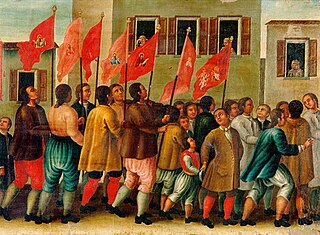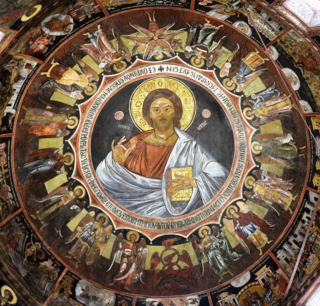
The Hellenic Armed Forces are the military forces of Greece. They consist of the Hellenic Army, the Hellenic Navy, and the Hellenic Air Force.

Hellenism in a religious context refers to the modern pluralistic religion practiced in Greece and around the world by several communities derived from the beliefs, mythology and rituals from antiquity through and up to today. It is a system of thought and spirituality with a shared culture and values, and common ritualistic, linguistic and literary tradition. More broadly, Hellenism centers itself on the worship of Hellenic deities, namely the twelve Olympians.

The Athens School of Fine Arts, is Greece's premier Art school whose main objective is to develop the artistic talents of its students.

The Byzantine and Christian Museum is situated at Vassilissis Sofias Avenue in Athens, Greece. It was founded in 1914, and houses more than 25,000 exhibits with rare collections of pictures, scriptures, frescoes, pottery, fabrics, manuscripts, and copies of artifacts from the 3rd century AD to the Late Middle Ages. It is one of the most important museums in the world in Byzantine Art. In June 2004, in time for its 90th anniversary and the 2004 Athens Olympics, the museum reopened to the public after an extensive renovation and the addition of another wing.
Theodoros Vryzakis was a Greek painter, known mostly for his historical scenes. He was one of the founders of the "Munich School", composed of Greek artists who had studied in that city.

The Heptanese School of painting succeeded the Cretan School as the leading school of Greek post-Byzantine painting after Crete fell to the Ottomans in 1669. Like the Cretan school, it combined Byzantine traditions with an increasing Western European artistic influence and also saw the first significant depiction of secular subjects. The school was based in the Ionian Islands, which were not part of Ottoman Greece, from the middle of the 17th century until the middle of the 19th century. The center of Greek art migrated urgently to the Ionian islands but countless Greek artists were influenced by the school including the ones living throughout the Greek communities in the Ottoman Empire and elsewhere in the world.

Theophanis Strelitzas, also known as Theophanes the Cretan or Theophanes Bathas was a Greek painter of icons and frescos in the style of the Cretan School. He passed much of his career as a member of the monastic community of Mount Athos.

San Giorgio dei Greci is a church in the sestiere (neighborhood) of Castello, Venice, northern Italy. It was the center of the Scuola dei Greci, the Confraternity of the Greeks in Venice. Around this period there was a similar church in Naples called Santi Pietro e Paolo dei Greci. There was also a Greek Brotherhood of Naples.

The Little masters were a group of potters and vase painters who produced vases of the Attic black-figure style featuring well-done figures in miniature. They were active in Athens approximately 560–530 BC. They mainly produced Little-master cups: lip cups, band cups, and droop cups, but were not entirely limited to such shapes. The group includes:
Events in the year 1984 in Greece.

Ioannis Moskos was a Greek painter that migrated to Venice. Two other very famous painters with the name Moskos were active around the same period Elias Moskos and Leos Moskos. Leos Moskos frequently traveled all over the Venitian Empire and was in Venice around the same period as Ioannis. He is not Elias Moskos's son. The Moskos painters may have had some relationship but documentation is unavailable. Ioannis painted in the traditional maniera greca and the Venetian style. His art resembles Michael Damaskinos and Andreas Pavias. He was affiliated with the church of San Giorgio dei Greci. He left a huge assortment of paintings that can be found all over the world. His most popular work is The Crucifixion.

Thomas Bathas was a Greek painter, educator, and Vikar. He employed the maniera greca in some of his work but he also broke from tradition by employing the Venetian style. He traveled around the Venetian Empire going from Heraklion to Corfu and Venice. He was a prominent member of the Greek Confraternity in Venice. He was friends with Gabriel Severus, Metropolitan of Philadelphia. He was very popular among both Greek and Italian patrons. He influenced the works of countless artists both Italian and Greek. Some of his works are in San Giorgio dei Greci and the Hellenic Institute of Venice. Emmanuel Tzanes, Konstantinos Tzanes, Ioannis Moskos, and Philotheos Skoufos were some Greek artists influenced by his work. One of his students was the famous painter Emmanuel Tzanfournaris. He left him a fortune in his will. His most famous works include: Portrait of Gabriel Severus and Virgin and Child Enthroned. Twenty of his paintings have survived.

Nikolaos Kallergis, also known as Kalergis. He was a Greek painter during the Greek Rococo and the Modern Greek Enlightenment in art also known as Neo-Hellenikos Diafotismos. His art also exhibited Venetian influence. Painters of the maniera greca began to refine their art. Philotheos Skoufos, Elias Moskos, and Theodore Poulakis were all active painters on the Ionian Islands prior to Kallergis. They set the stage for the transition to the Heptanese School. Panagiotis Doxaras is the forefather of the new painting style. He was the father of Greek Rococo and the Modern Greek Enlightenment in painting. Kallergis became an active member of the school. Kallergis also represents the Greek Rococo. His art began to exhibit qualities of Greek and Italian Neoclassicism. His style influenced countless painters. Examples include Nikolaos Kantounis, Nikolaos Koutouzis, Nikolaos Doxaras, Spiridione Roma, and Eustathios Karousos. His most famous work is Christ and Angel it is at the Zakynthos Museum.

Emmanuel Skordilis, also known as Emmanouil Skordilis. He was a Greek Renaissance painter. He was active in Crete around the time Emmanuel Tzanes, Elias Moskos, and Philotheos Skoufos were painting in Crete. He belongs to the elite group of Greek painters that followed the Venetian influenced maniera greca in Crete. Sixty eight of his works survived. He is one of few artists to not travel to the Ionian Islands and participate in the Heptanese School. He eventually settled in the Cyclades on the inland of Milos. Christodoulos Kalergis is another prominent Greek artist associated with the Cyclades, he was from Mykonos. Skordilis was influenced by Georgios Klontzas, Michael Damaskinos and Angelos. Skordilis brought the artistic style of Crete to the Cyclades and influenced countless artists in that region.

Stylianos Stavrakis, was a Greek painter during the Neo-Hellenic Enlightenment era in art. He was a goldsmith and painter. He was very active on the Ionian Islands. Nikolaos Koutouzis, Nikolaos Doxaras and Nikolaos Kallergis were all active in Zakynthos during the same period. He is a prominent member of the coveted Heptanese painting style. He comes from a family of painters. His brother Andreas Stavrakis and nephew Demetrios Stavrakis were both famous painters. He influenced countless artists. Konstantinos Kontarinis and other artists of the Ionian Islands began to emulate his work. His most notable work is The Deposition from the Cross (Stavrakis). Fourteen of his paintings survived. Most of them can be found in Zakynthos, Greece.

Ioannis Korais was a Greek painter. He was a prominent member of the Heptanese School. His contemporaries were Nikolaos Doxaras and Nikolaos Koutouzis. His family was from the island of Chios. He was the grandson of the painter Michael Korais from Chios. He helped revolutionize Greek painting. He was a follower of Panagiotis Doxaras and the new techniques he was employing.

Georgios Markou also known as Georgios Markou of Argos (Greek: Γεώργιος Μάρκου ο Αργείος. He was a Greek fresco and icon painter. He was active during the Greek Baroque and Rocco periods. He was an artistic representative of the Neo-Hellenikos Diafotismos. He was one of the few Greek painters that worked outside of the Ionian Islands. Other painters that worked outside the Ionian Islands were Christodoulos Kalergis and Makarios. They were also fresco painters. Other Greek fresco painters that traveled all over Greece were Fragkos Katelanos, Theophanes the Cretan, and Frangos Kontaris. Markou was also one of the few prominent painters to have painted in Athens. His surviving works can be found all over the ancient city. He also completed works on the island of Salamina. Three icons survived and countless frescos exist at seven different sites. Some of the frescos are in very good condition. His most notable frescos are at the Monastery Faneromeni, Salamina, Greece.
Manolis Chatzidakis was a Greek Byzantinist. He significantly contributed to the history of art of Greece. He specialized in the field of Byzantine and Post-Byzantine painting. He is considered the 20th century Giorgio Vasari and Bernardo de' Dominici. He was an archeologist, art historian, author, lecturer and curator. He also spoke Arabic and contributed to the field of Islamic art. He helped saved countless artifacts.

The Virgin of the Passion is a famous rendition of the Madonna and Child by Greek painter Emmanuel Tzanfournaris. He was born in Corfu to the painter Georgios Tzanfournaris. By age twenty-nine Emmanuel moved to Venice. Emmanuel's teacher was painter Thomas Bathas. He met him on the island Corfu. Bathas left Emmanuel a sizable fortune in his will. Both painters created a famous version of the Virgin and Child. The Bathas version is called Virgin Nikopoios.

Mary Magdalene is a tempera painting by Konstantinos Tzanes. Tzanes was a Greek painter active during the late Cretan Renaissance. Tzanes and his brothers migrated from Crete to Venice. His brother was famous painter Emmanuel Tzanes. They were both active during the 17th century. Twenty-one of his paintings survived. Both brothers uniquely contributed to the maniera greca. They made drastic improvements to the style redefining space and color. Their work is comparable to Michael Damaskinos.
![]() This article incorporates text from a publication now in the public domain : Urlichs, Ludwig (1870). "Ctesilochus". In Smith, William (ed.). Dictionary of Greek and Roman Biography and Mythology . Vol. 1. p. 900.
This article incorporates text from a publication now in the public domain : Urlichs, Ludwig (1870). "Ctesilochus". In Smith, William (ed.). Dictionary of Greek and Roman Biography and Mythology . Vol. 1. p. 900.















